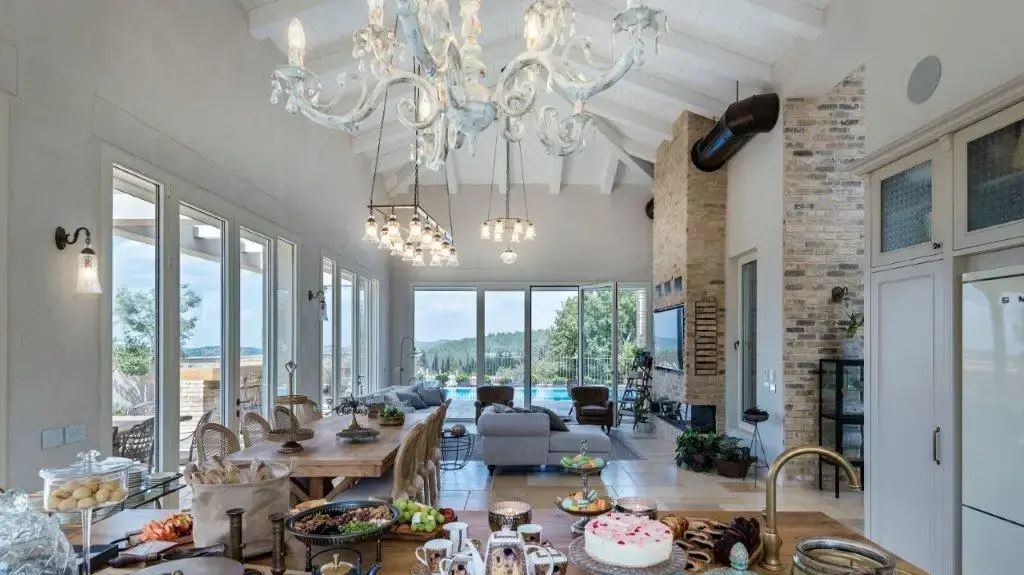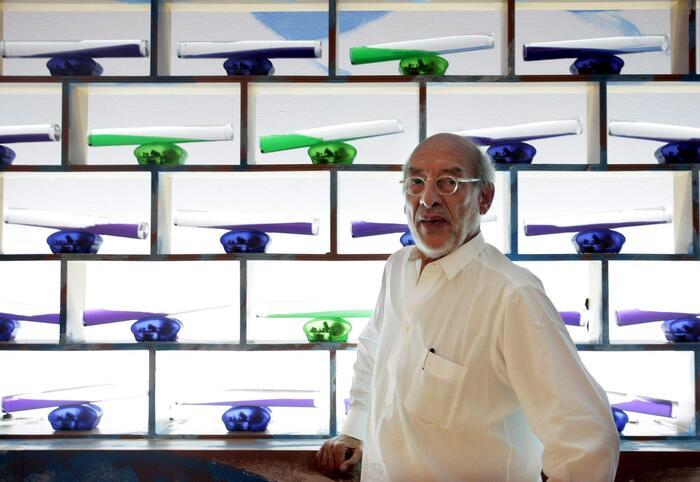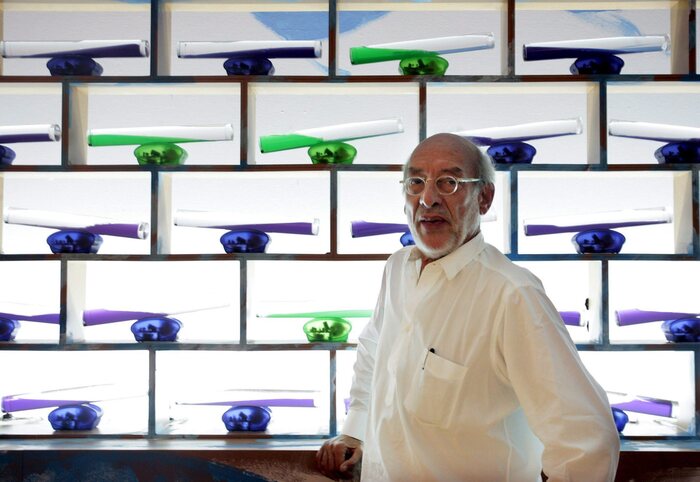Much has been said about the
'Bakalao' Route
- the true professionals called it the Destroy Route - as a waste of
drugs
, excessive characters and sunrises among orange trees.
But little is known how the exteriors and interiors of the
nightclubs were created
where from Friday to Monday an entire generation retaliated from Franco's ties to the rhythm of the most avant-garde sounds that gave way to the “mákina”, the Valencian variant that was anticipated to
hard techno
and
German
hard trance
.
The mythical venues were not built
ad hoc
to host this movement that was ahead of the
raves
of England, crossing the limits of nightlife as it was known until that moment.
The
architecture
was already there to be occupied with designs such disparate influences as Italian neorealism, the Cold War or the circus world.
“Three eras can be distinguished.
The first was the appropriation of the premises of the city center.
Then they went to the disused warehouses and agricultural buildings and, finally, with the commercialization, they started to occupy the
parking lots
”, says Joaquín Juberías, Valencian architect and author, together with the architect Àlex Martínez, of a research on the evolution of the places on the Bakalao route, published in the now defunct
Displacements Journal
of the Madrid School of Architecture (ETSAM), which we recover in this article.
In the late 1970s, Valencia was a hotbed of urban tribes.
Rockers, mods, goths and punks began to rent the decaying dance halls of the city center, such as
Oggi
(later
Metropolis
) or
Calavera
, in order to redesign them in an ephemeral way and celebrate their theme parties there.
Soon they were small.
"The lack of regulation of night hours was the perfect breeding ground," explains Martínez.
The need for a larger capacity led them to search the neighboring municipalities, where there was no threat of new, more restrictive regulations.
To take advantage of the inertia of the moment, it was concluded that, instead of building new spaces for this use, the most practical thing was to occupy the autochthonous constructions inherited from the Valencian agrarian system.
Chocolate Cream
, which was born as a funky nightclub in the late seventies, took over a rice warehouse.
Barraca,
the typical home of the Valencian farmers of the same name.
ACTV,
the Victoria Baths building.
El Molí,
an old windmill.
Dream Village, it
was a country house.
And
Placton,
a construction of fishermen.
"Each temple had its own audience," says Martínez.
In the 1980s, the British architecture writer and critic Reyner Banham proclaimed that all the necessary architectures had already been built and that existing ones had to be used for reprogramming.
"It is not that they had that idea present, but the attitude was that", explains the architect.
To theorize about what was happening there, the authors of the research cite the words of the Valencian artist Ulises Pistolo, a regular on the Route: "They were isolated fragments of land outside the
status quo
."
They compare them to the Temporarily Autonomous Zones (ZTA) of the American anarchist essayist Hakim Bey.
These spaces of social relationship not mediated by coercion, born, among other origins, of the identity party, according to Bey, adapt to what they were looking for from the Valencian urban tribes to detect the legislative gaps and expand their “cultural journey”.
Known is the cleaning time between sessions or the compatibility of use: open early as a picnic area and later as a disco.
In this way, it was possible to complete the 72 hours that the party lasted without apparently breaking any regulations.
The pioneers were Barraca, inaugurated as a nightclub in 1965, but whose boom began in the early eighties, and Chocolate Cream, which broke in shortly after.
"The first was more playful and festive, the second, more sinister," recalls Juberías.
Both rooms, located a few meters away in the hamlet of Sueca, were originally created funky by the Valencian designer Nacho Moscardó.
Barraca maintained the agricultural structure of its interior and stood out for the ephemeral infrastructure that was installed in 1980 to host performances:
“El Circo”
.
Despite being a lightweight, dry-assembled and demountable architecture, it was conceived as a permanent installation that would function as a stage.
In Barraca you could enjoy its pool, attend a play or even cabaret sessions.
With the arrival of
DJ Carlos Simó
, a regular at London's record stores, Sex Pistols, The Stone Roses, Happy Mondays and almost all the music adhered to the
new wave
or the
new romantics began to play
.
Chocolate Cream was designed in 1979 as a reflection of the Ibiza nightclubs and the
Flower Power Parties
.
Its brown exterior originally imitated, in its Moscardó design, a chocolate cake with cream on top.
Inside, the sofas looked like pastels, the air conditioning tubes were curled up, and there were artificial plants in blue and pink, colored spotlights, and lots of fluorescence.
It was inspired by the masters of Italian fiction.
From Dante Ferreti to Pier Paolo Pasolini or Luchino Visconti.
It was a kind of interruption of reality that acted as a gateway to fiction.
In 1982, when DJ Toni Vidal, better known as Toni El Gitano, arrived, without making any major changes to the interior at first, the room was left as “Chocolate” and was darkened to create a gloomy atmosphere under the influence of groups like Cabaret Voltaire, The Cult, Bauhaus or The Mission.
They even organized séances.
The theming of the interiors imposed by Chocolate and Barraca influenced the
Spook Factory
project
.
Its opening in 1984, in what was the San Francisco nightclub for vacationers, located in Pinedo, marked the start of what would begin to be known as
the Route.
Designer
Miguel Ángel Rey
was inspired by the geopolitical context of the Cold War and nuclear paranoia to create a dystopian space.
Its interior, painted black and without windows, caused a space-time rupture that broke the day-night sequence.
Disc jockey
Fran Lenaers
connected the audience with the environment by mixing the same song with two decks simultaneously to create the characteristic sound of a bunker, using the bases of pioneering groups of EBM (Electronic Body Music).
The themes of the Belgians Front 242, the British Nitzer Ebb or the Germans Kraftwerk and DAF (Deutsch Amerikanische Freundschaft) were the favorites to provoke this festive uneasiness.
Spook was the first room with an "official" morning session.
To comply with current legislation, it
closed
for an hour at six in the morning, stopped the music and turned on the lights with the public inside and in full swing, and then resumed until noon.
His now mythical posters, with the famous bat logo created by fashion designer Valentín Herraíz, bore the signature of Javier Mariscal, the father of the Cobi mascot.
This is how the legend of the road began, and the trips along the N-3 between Madrid and Valencia, which brought characters such as Pedro Almodóvar, Javier Bardem, Antonio Banderas, Carmen Maura and Miguel Bosé to this part of the peninsula.
With the success of Spook, at the end of the eighties, the rooms began to multiply as exclusive temples of electronic music and
paleo-techno
.
It was then that mescaline, a native drug with psychedelic and visionary effects derived from the cactus and synthesized by local pharmacists, began to be replaced by designer drugs from the Netherlands, amphetamine-based, which increased the heart rate and were more conducive to patients. Machina rhythms that gave rise to the great temples of sound, closed and dark.
The opening of
Puzzle made up
for Barraca's lack of capacity.
Then
ACTV
arrived
, the only one that occupied a building within the city, a modernist construction from 1918, and it became the place that closed the Route, opening from dawn on Sunday until noon on Monday.
Its mythical logo with a face with a white background and black crosses in the eyes was the work of the artist
Quique Company
in collaboration with the reference designer Paco Bascuñán, member of the Royal Academy of Fine Arts of Valencia, who was also in charge of the interiors of the local, pioneer in the use of devices such as the atmospheric visual effects laser imported from Berlin.
In 1990 Don Julio (
NOD
) arrived on the outskirts of the town of Ribarroja.
It was the pioneer of parties in the parking lot, enlivened by
DJ Kike Jaen
and with paella included on Sunday mornings.
The claim of Valencian leisure began to have such an impact that his day went from 36 to 72 hours.
“The party started on the bus heading to Valencia.
They gave you a ticket and a condom ”, Juberías recalls.
This popularization caused many people to convert the car parks into the new dissident territories (or ZTA) to avoid the new mass reality that was beginning to lose its original identity
.
The party became more visible.
The problems began.
In turn, the rise of entertainment venues coincided with the rise of MTV and the Top 40 music charts.
In the programming of both media, some of the machineries were already included.
People began to ask the dj what he had to play, which was what he had heard on the radio.
The night became the new object of mass consumption.
In May 1993, the report “Until the body holds”, presented by
Carles Francino
on Canal +, which followed a group of young people who were going by bus from Barcelona to Valencia, changed everything.
Or rather, it ended everything.








